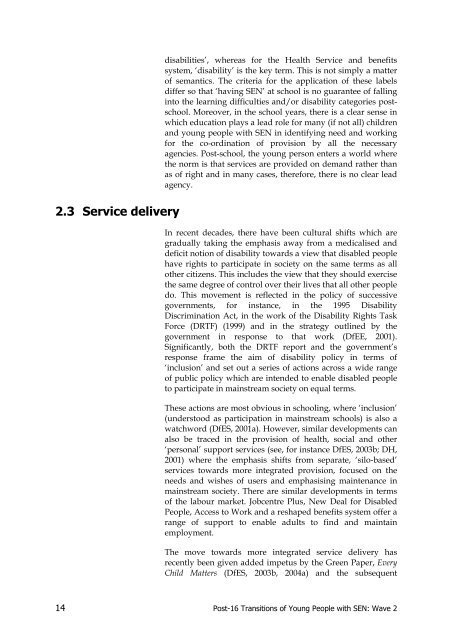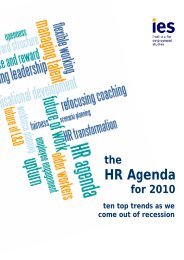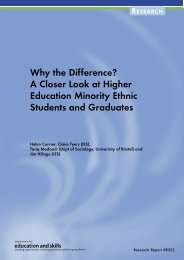Post-16 Transitions: a Longitudinal Study of Young People with ...
Post-16 Transitions: a Longitudinal Study of Young People with ...
Post-16 Transitions: a Longitudinal Study of Young People with ...
You also want an ePaper? Increase the reach of your titles
YUMPU automatically turns print PDFs into web optimized ePapers that Google loves.
disabilities’, whereas for the Health Service and benefits<br />
system, ‘disability’ is the key term. This is not simply a matter<br />
<strong>of</strong> semantics. The criteria for the application <strong>of</strong> these labels<br />
differ so that ‘having SEN’ at school is no guarantee <strong>of</strong> falling<br />
into the learning difficulties and/or disability categories postschool.<br />
Moreover, in the school years, there is a clear sense in<br />
which education plays a lead role for many (if not all) children<br />
and young people <strong>with</strong> SEN in identifying need and working<br />
for the co-ordination <strong>of</strong> provision by all the necessary<br />
agencies. <strong>Post</strong>-school, the young person enters a world where<br />
the norm is that services are provided on demand rather than<br />
as <strong>of</strong> right and in many cases, therefore, there is no clear lead<br />
agency.<br />
2.3 Service delivery<br />
In recent decades, there have been cultural shifts which are<br />
gradually taking the emphasis away from a medicalised and<br />
deficit notion <strong>of</strong> disability towards a view that disabled people<br />
have rights to participate in society on the same terms as all<br />
other citizens. This includes the view that they should exercise<br />
the same degree <strong>of</strong> control over their lives that all other people<br />
do. This movement is reflected in the policy <strong>of</strong> successive<br />
governments, for instance, in the 1995 Disability<br />
Discrimination Act, in the work <strong>of</strong> the Disability Rights Task<br />
Force (DRTF) (1999) and in the strategy outlined by the<br />
government in response to that work (DfEE, 2001).<br />
Significantly, both the DRTF report and the government’s<br />
response frame the aim <strong>of</strong> disability policy in terms <strong>of</strong><br />
‘inclusion’ and set out a series <strong>of</strong> actions across a wide range<br />
<strong>of</strong> public policy which are intended to enable disabled people<br />
to participate in mainstream society on equal terms.<br />
These actions are most obvious in schooling, where ‘inclusion’<br />
(understood as participation in mainstream schools) is also a<br />
watchword (DfES, 2001a). However, similar developments can<br />
also be traced in the provision <strong>of</strong> health, social and other<br />
‘personal’ support services (see, for instance DfES, 2003b; DH,<br />
2001) where the emphasis shifts from separate, ‘silo-based’<br />
services towards more integrated provision, focused on the<br />
needs and wishes <strong>of</strong> users and emphasising maintenance in<br />
mainstream society. There are similar developments in terms<br />
<strong>of</strong> the labour market. Jobcentre Plus, New Deal for Disabled<br />
<strong>People</strong>, Access to Work and a reshaped benefits system <strong>of</strong>fer a<br />
range <strong>of</strong> support to enable adults to find and maintain<br />
employment.<br />
The move towards more integrated service delivery has<br />
recently been given added impetus by the Green Paper, Every<br />
Child Matters (DfES, 2003b, 2004a) and the subsequent<br />
14 <strong>Post</strong>-<strong>16</strong> <strong>Transitions</strong> <strong>of</strong> <strong>Young</strong> <strong>People</strong> <strong>with</strong> SEN: Wave 2

















